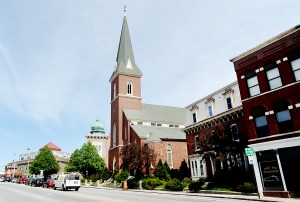LEWISTON — Central Maine Healthcare’s plan to raze the former St. Joseph’s Church must await action by the city’s Historic Preservation Review Board and a 90-day comment period before demolition can begin on the Main Street landmark.
At the earliest, demolition could start on Oct. 1, said Gil Arsenault, the city’s director of planning and code enforcement. And it could be later.
The 253 Main St. structure — the oldest Catholic Church in the city — has been idle since October 2009. The Prince of Peace Parish put the church building on the market, saying it could no longer afford to operate it. In May, Central Maine Healthcare purchased the 156-year-old building and the adjacent rectory for $125,000.
The heath care group plans to raze the church to create 50 or more parking spaces.
The building is “unsafe,” CMH spokesman Chuck Gill said last week. The foundation is in poor shape, he said.
Central Maine Healthcare will have to prove to the city’s Historic Preservation Review Board that the church building would be “uneconomical” to maintain, Arsenault said.
The hospital group, the parent company of Central Maine Medical Center, likely will be asked to produce a structural analysis proving the building’s deficiencies. Members of the preservation group will likely tour of the church, Arsenault said.
“It does distress me some that yet another church building is being destroyed, and it’s not any old church building,” said Douglas Hodgkin, a member of the city’s preservation group and a local historian.
It was a key structure for the immigrant Catholic community, he said.
The cornerstone of the building was laid June 13, 1864, according to a parish history published in 2007. The church was designed by architect Patrick Keely of New York and opened in 1897.
The building was known for its columned nave and stained glass in almost every window, much of it hand-painted with extraordinary detail. Murals were painted in the 1920s by Monmouth artist Harry Cochrane, according to the church’s history.
“(Immigrants) spent not only their money,” Hodgkin said. “They spent their blood, sweat — a lot of sweat — in the construction of the building.”
He said the Historic Preservation Review Board would have little power to stop the demolition of the former St. Joseph’s church, even if it wanted to.
“We’re not a very powerful board,” he said. “We can’t stop demolition of a building.”
However, if the board disagrees with Central Maine Healthcare’s portrait of a building that’s too costly to maintain, it’s uncertain what would happen, Arsenault said.
“That’s never really been tested,” he said.
In January 2011, the United Baptist Church across Main Street was razed after sitting on the market for years. It became a parking lot.
In that case, the economics were easier, Arsenault said.
“That building was in dire straits,” he said. Its stone masonry was crumbling and a fix was estimated to cost more than $1 million.
The former St. Joseph’s Church’s problems appear to be less obvious, he said. On Tuesday, Arsenault walked around the building’s exterior. He looked for faults and found few.
“I don’t know how much damage there is in that building,” he said.
Even if the Historic Preservation Review Board approves Central Maine Healthcare’s certificate of appropriateness, allowing a building permit to be issued for demolition, a three-month waiting period would be enforced before the walls come down.
“Basically, it’s a warning to people, ‘Look; this building’s going to come down unless somebody steps to the plate,'” Arsenault said.
Such a last-minute reprieve is “pretty remote in this economy,” he said. “Speak now or forever hold your peace,” he said. “That’s what it’s all about.”

Comments are no longer available on this story